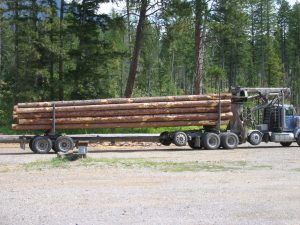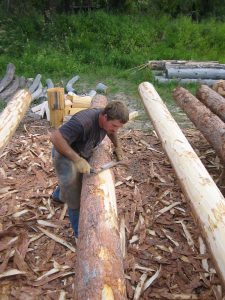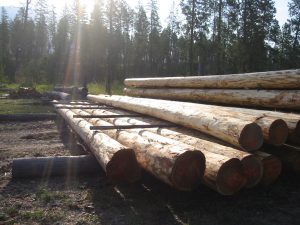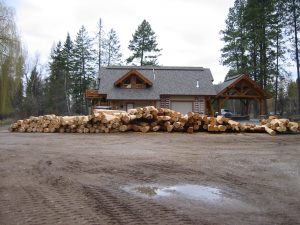Using Western Larch for Full Scribe Handcrafted Log Homes
The golden hills of North West Montana radiate in autumn light…..oh the Larch!
The last of our species discussion will conclude on Western Larch. If I had just a few words to describe this species it would be strong, honest and true. This is my favorite wood to use. Not because it is easy, takes less time or more economical. But I know that if handled properly it will be there forever.
Like the previous two species, Larch exhibits the qualities of tall, straight and lack of taper in spades. When walking through a stand of Western Larch and time is taken to slow down and study; one knows viscerally why this species makes a good building log.
Furthermore, log builders of the past sought out this species when crafting there creations. In our area the depression era, WPA projects (Buffalo Hill, Whitefish Lake and Polson Golf Club) are a testament to the species quality and longevity. The Kootenai Lodge structures on Swan Lake built nearly 100 years ago by copper king industrialists still stand tall and true.
Western Larch Pros:
- Good availability in NW Montana and throughout the northern Rocky Mountain region.
- Available in large diameters, 12” top diameter is common, with larger sizes available.
- Grows very tall and straight with little taper.
- Good rot resistance-of the common species available to us, next to Western Red Cedar, Western Larch has the best decay resistance.
- Engineering profile is compatible with Douglas Fir-20% greater deflection resistance than white wood species. Many times these two woods will be specified in load bearing areas.
- Seasons and inventories well. I prefer buying this species green (winter cut if project allows), debarking, spacing for air flow and seasoning prior to using. This species can season for several years without degrading.
- Tough durable wood that can take more abuse than white wood species.
- If combined with good handcrafted log home design practices and subjected to good maintenance practices; a home owner using this wood could see longevity of many generations.
Western Larch Cons:
- Heavy in weight, thus more costly for shipping. This is not so much an issue when building locally.
- Pitch pockets can drip pitch during the drying cycle. Most evident on ends of logs. (It’s a nuisance issue not a structural one)
- Can check a fair amount if subject to quick drying. Wall logs benefit from kerf cutting on tops of logs to relieve drying stresses.
- Not a good candidate for using in full scribe structures in a dead standing state, as wood gets very hard. It is therefore more difficult to carve and craft. I like using it in a seasoned state when it still has some moisture in it. As a result strict settlement allowances must me adhered to.
- As with all heavily barked species, bark must come off fairly quickly after harvesting otherwise it is subject to boring beetles.
A project using Western Larch for a Middle Fork of The Flathead River Home:
I was approached some 30 years ago by Mike and his contractor Joe Boggess about his project to build a second home along the banks of the Middle Fork of the Flathead. Joe had a reputation of working on some of the finest log projects in the Flathead Valley at the time and I always marveled at his finish work capabilities. His projects had the look of fine furniture when finished-I welcomed the opportunity to work with the two of them.
Joe had recently finished up a large residence using Western Larch and had a preference for working with it. As we sourced logs locally for the project and the log truck loads started coming to our yard I immediately knew we had some quality material for this project. This would be my first time working with this material, but would soon become my preference. I have since used it on many projects since
Logs were debarked while plans where being drawn up. 
 Logs were then staged for seasoning with Lodge Pole rails separating courses to let air circulate around the logs.
Logs were then staged for seasoning with Lodge Pole rails separating courses to let air circulate around the logs.  Construction of the log work began after plans were produced and logs seasoned through the summer months. Walls were scribe fitted using shallow lateral grooves to accommodate foam gasket material. Corners were done in the shrink-fit saddle notch style.
Construction of the log work began after plans were produced and logs seasoned through the summer months. Walls were scribe fitted using shallow lateral grooves to accommodate foam gasket material. Corners were done in the shrink-fit saddle notch style.  Prior to delivery the logs were clean peeled, to rid the surface of any weathering, remaining bark and construction marks. Foam gasket material was stapled in notch work and logs were staged for loading and delivery in our log yard.
Prior to delivery the logs were clean peeled, to rid the surface of any weathering, remaining bark and construction marks. Foam gasket material was stapled in notch work and logs were staged for loading and delivery in our log yard. 

While setting the structure up it became apparent to me that this would be a special place. The setting of this home is stunning. The Middle Fork of the Flathead is less than a stones throw from the front deck. When sitting on the deck you hear, see and feel the river. Across the river is Glacier National Park. I was able to keep visiting the place during construction as my wife’s aging grandparents lived in Cut Bank Mt at the time and we would swing in as we traveled up Marais Pass. Joe was doing a stunning job finishing the place.
Fast forward 25 years and 200 log projects later, I had not seen Mike in years he called me up out of the blue to see if we were interested in doing some building and maintenance projects around his house. Mike had moved up to the log house full time, had married and was living a good life. Mike and his wife LaVonne are some of the nicest people one could ever meet. We were able to fit the work in our schedule and off we went. What started as a few weeks of re-staining sealant work turned into several months of custom built doors, new porch and deck, new wood shed and two custom built rockers. We spent the warm days of August staining the logs and sealing the corner joinery with Conseal by Sash Co, a flexible, textured caulking. The cool months of fall were spent on a new covered deck and building doors back at the shop.
The take away for me after working around the house for a couple months was just how well the logs were holding up. On the north and covered porch sides once the dust was scrubbed off, the logs looked almost new and with a maintenance coat of finish they looked as good as new. Minimal checking, zero degradation due to decay-this place could stand for centuries. Mike runs a tight ship at his place, nothing is out of place and the place is kept spotless-no doubt this helped in keeping this place looking good but the tight grained, hard as nails Larch logs were part of it as well.
This place stands out in my mind as a favorite of over 225 log structure built at Old Style. The setting, the river rock fire place with rock from the Middle Fork and the beautiful Larch logs full-scribed to each other make it an unforgettable place.
DM

